Biomethane Market Overview:
The global biomethane market size was valued at $3.1 billion in 2022, and is projected to reach $5.5 billion by 2032, growing at a CAGR of 5.7% from 2023 to 2032. The rising demand for renewable energy sources and the growing focus on reducing greenhouse gas emissions are key drivers propelling the biomethane market. As global efforts intensify to transition from fossil fuels to cleaner energy alternatives, biomethane emerges as a sustainable solution. As a result, there is expected to be high demand for the biomethane market.
Key Market Insights
- By Production Method, Anaerobic digestion led the market in 2022. It will grow faster in the forecast period.
- By Application, The automotive segment led the biomethane market and will continue its dominance.
- By Region, Asia-Pacific led the biomethane market in 2022 and is expected to grow at 6.0% CAGR.
Market Size & Forecast
- 2032 Projected Market Size: USD 5.5 Billion
- 2022 Market Size: USD 3.1 Billion
- Compound Annual Growth Rate (CAGR) (2022-2031): 5.7%
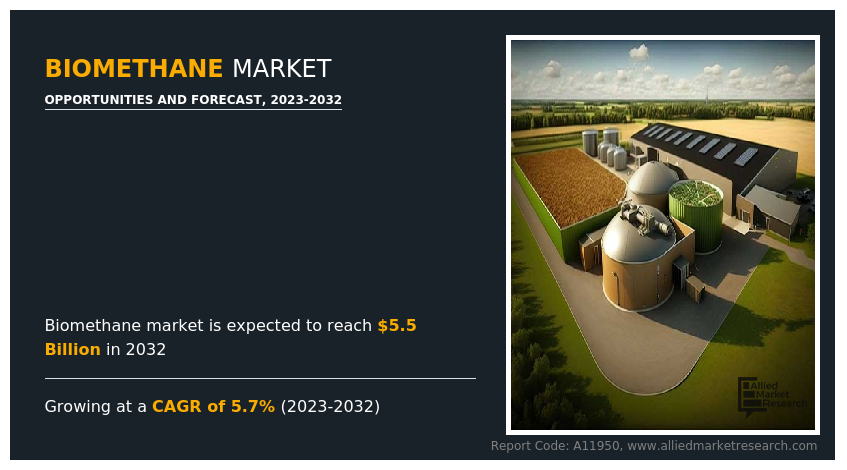
How to Describe Biomethane
Biomethane, known as renewable natural gas (RNG), is a type of gas derived from the biological breakdown of organic matter, such as agricultural waste, food waste, sewage, and other organic materials. It is a renewable energy source and is considered a sustainable alternative to fossil fuels. The production of biomethane involves a process called anaerobic digestion. In anaerobic digestion, microorganisms break down organic matter in the absence of oxygen, resulting in the production of biogas. Biogas primarily consists of methane (CH4) and carbon dioxide (CO2), along with lesser amounts of other gases. Biogas undergoes a purification process to remove impurities, such as carbon dioxide and hydrogen sulfide to convert it into biomethane. The purified biogas, which is methane, is then compressed and upgraded to meet pipeline quality standards. The resulting biomethane is injected into the natural gas grid, used as a vehicle fuel, or utilized for heating and power generation.
How are Market Dynamics Shaping Industry Competition:
Biomethane offers several environmental benefits. It is a renewable energy source since it is derived from organic waste that is anticipated to otherwise decompose and release methane into the atmosphere, a potent greenhouse gas. Biomethane production helps to reduce greenhouse gas emissions and mitigates climate change by capturing and utilizing this methane. Moreover, biomethane has a lower carbon footprint compared to conventional natural gas, as it is produced from waste materials rather than extracted from fossil fuel reserves. Furthermore, biomethane production contributes to waste management by providing an outlet for organic waste materials. It is projected to help divert waste from landfills, reducing methane emissions and potential environmental pollution.
In addition to its environmental advantages, biomethane offers energy security benefits. It provides a local and decentralized source of energy, reducing dependence on imported fossil fuels. Moreover, it promotes the development of a circular economy, as waste materials are recycled and used to generate valuable energy. Overall, biomethane is an important renewable energy resource with numerous environmental and energy-related benefits. Its production and utilization contribute to reducing greenhouse gas emissions, waste management, and energy diversification. Such benefits and advantages act as driving forces for the biomethane market growth.
Securing a consistent and dependable supply of organic waste materials is a prerequisite for biomethane production. The availability and accessibility of these resources are anticipated to fluctuate due to geographical and seasonal factors, though there is considerable potential for feedstock from agricultural residues, food waste, and wastewater. Maintaining a steady supply of feedstock is anticipated to pose challenges, particularly for smaller scale biomethane projects. Setting up a biomethane production facility entails significant initial investment expenses. This includes the construction of anaerobic digesters, gas upgrading systems, and the necessary infrastructure for feedstock collection and processing. These capital expenditures are projected to be substantial.
In addition, biomethane production involves intricate technological processes that require continuous optimization to enhance efficiency and cost-effectiveness. Afore-mentioned challenges are major hurdles for the biomethane industry to make the production of biomethane more economical. The mentioned factors affect the biomethane market growth and act as a restraining force.
Ongoing advancements in anaerobic digestion processes and supportive policies have helped to overcome these obstacles and promote broader adoption of biomethane as a sustainable energy option. Efforts are being made to diversify feedstock sources, develop more efficient anaerobic digestion systems, and reduce the costs associated with biomethane production. In addition, supportive policies, financial incentives, and partnerships between governments, industry stakeholders, and research institutions have played a crucial role in promoting the development of the biomethane sector. Such advances and support from the government create high potential and growth opportunities for the industry players of the biomethane market.
Biomethane Market Segment Review:
The biomethane market is segmented into feedstock, production method, application, and region.
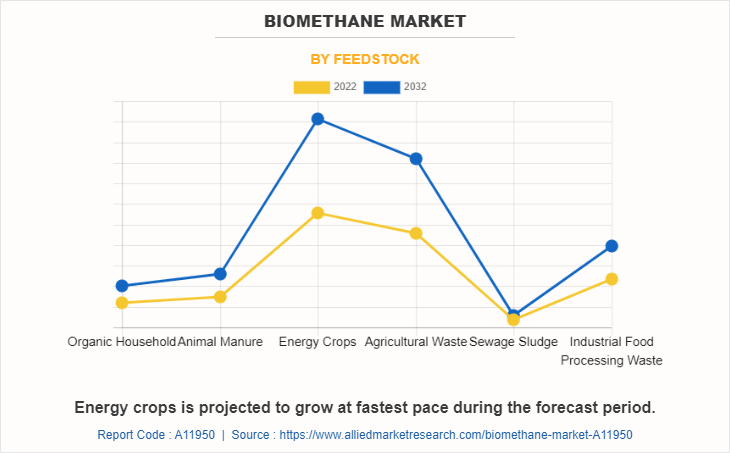
Biomethane Market By Feedstock
On the basis of feedstock, the market is segregated into organic household, waste derives, animal manure, energy crops, agricultural waste, and sewage sludge. Energy crops segment dominated the biomethane market share for 2022 and is expected to grow at a higher CAGR during the projection years. Energy crops can be used as feedstock for biomethane production. Energy crops are specifically grown for the purpose of producing bioenergy, including biomethane. These crops are selected for their high biomass yield and energy content, making them suitable for conversion into renewable fuels.
Energy crops are typically processed through anaerobic digestion, similar to other organic feedstocks when used for biomethane production. The crops are harvested and then subjected to anaerobic conditions, where microorganisms break down the biomass and produce biogas. Biogas primarily consists of methane (CH4) and carbon dioxide (CO2). It undergoes a purification process to remove impurities such as carbon dioxide and other trace gases to convert biogas into biomethane. Energy crops provide a dedicated and renewable source of biomass for biomethane production. The availability of feedstock for biomethane production is anticipated to be increased, ensuring a steady supply by cultivating specific crops with high biomass yield.
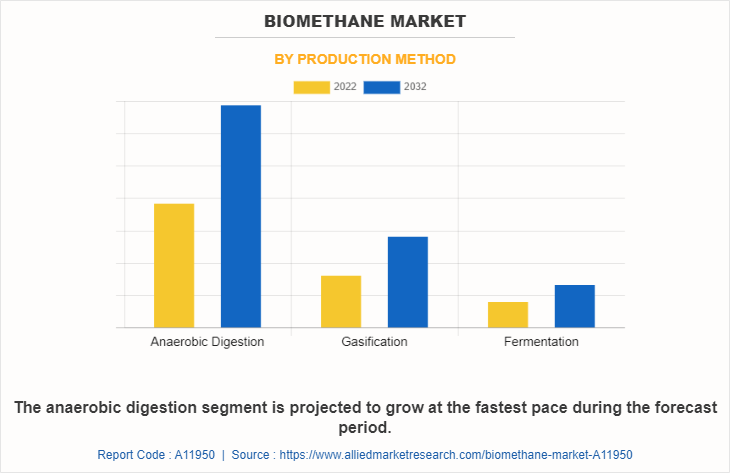
Biomethane Market By Production Method
On the basis of production method, the biomethane market is categorized into anaerobic digestion, gasification, and fermentation. The anaerobic digestion segment dominated the market for 2022 and is expected to grow at a higher CAGR during the biomethane market forecast period. Anaerobic digestion is a biological process that is anticipated to be utilized to produce biomethane, a renewable form of natural gas. It involves the breakdown of organic materials in the absence of oxygen by microorganisms, leading to the production of biogas, which primarily consists of methane (CH4) and carbon dioxide (CO2), along with traces of other gases. It takes place in a controlled environment such as an anaerobic digester. Organic materials, such as agricultural waste, animal manure, sewage sludge, or food waste, are fed into the digester, where microorganisms break them down through a series of biochemical reactions. These reactions produce biogas as a result.
Biogas generated from anaerobic digestion typically consists of methane (50-75%), carbon dioxide (25-50%), and trace amounts of other gases such as nitrogen, hydrogen, and hydrogen sulfide. The exact composition depends on the feedstock and process conditions. Biogas needs to be purified and upgraded to remove impurities, especially carbon dioxide and other trace gases, to produce biomethane. This upgrading process increases the methane content to over 95%, making it suitable for injection into the natural gas grid or use as a vehicle fuel.
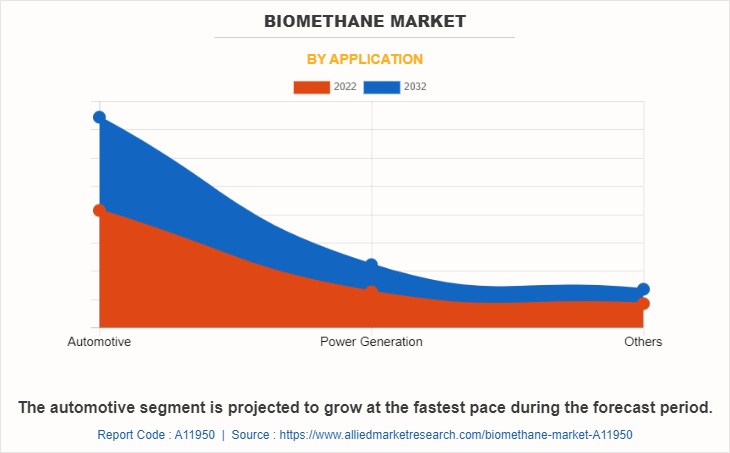
Biomethane Market By Application
On the basis of application, it is fragmented into power generation, automotive, and others. The automotive segment dominated the biomethane market growth and is projected to maintain its dominance during the projection years. Biomethane is anticipated to be used as a transportation fuel in vehicles designed to run on compressed natural gas (CNG) or liquefied natural gas (LNG). These vehicles are commonly referred to as natural gas vehicles (NGVs). NGVs are expected to be passenger cars, buses, trucks, or even specialized vehicles for specific purposes such as waste collection or delivery services. Biomethane as a fuel for NGVs offers similar performance characteristics to conventional natural gas. It provides good engine power and torque, resulting in comparable performance to vehicles running on gasoline or diesel. NGVs powered by biomethane are projected to achieve similar driving ranges and acceleration as their fossil fuel counterparts.
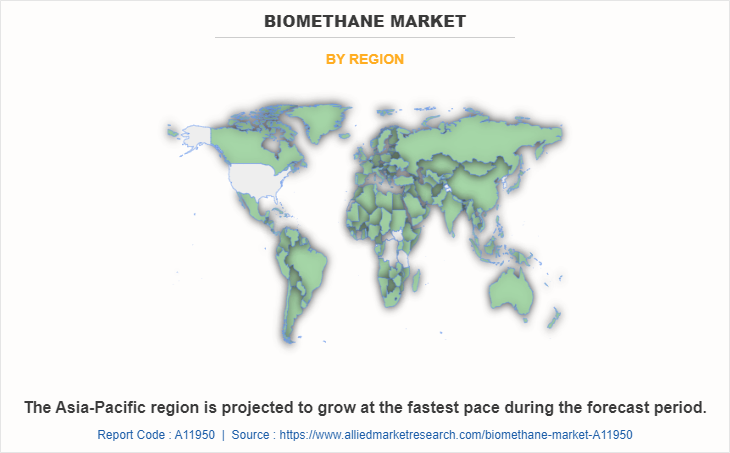
Biomethane Market By Region
Region-wise, biomethane market analysis is done across North America, Europe, Asia-Pacific, and LAMEA. The Asia-Pacific region dominated the biomethane market size in 2022 and will continue to grow at a higher CAGR of around 6.0%. Japan has been exploring the production of biomethane from different organic waste sources, such as agricultural residues, food waste, and sewage sludge.
Biomethane consumption in Japan is primarily focused on its use as a transportation fuel, particularly for buses and trucks. The government has set targets to increase the adoption of biomethane in the transportation sector to reduce greenhouse gas emissions and promote clean energy. Australia has been gradually increasing its biomethane production capacity, from agricultural waste, food processing waste, and organic municipal waste. The country has several anaerobic digestion facilities that produce biomethane. South Korea has been actively promoting the production of biomethane as part of its renewable energy initiatives. The country utilizes various organic waste sources, including agricultural residues, food waste, and sewage sludge, to produce biomethane through anaerobic digestion.
Biomethane consumption in South Korea focuses on its use as a transportation fuel. In some countries in Asia-Pacific region, specific regulations govern biomethane production, grid injection, and transportation fuel use. These regulations are anticipated to include certification standards, feed-in tariffs, incentives, and emissions reduction targets. For instance, China has implemented the Renewable Energy Law, which supports the development of renewable energy sources, including biomethane. India has the Sustainable Alternative toward Affordable Transportation (SATAT) initiative, which aims to promote the use of compressed biogas (CBG) as a transportation fuel.
Competitive Analysis
The key players operating in the biomethane industry. These players have been adopting various strategies to gain a higher share or to retain leading positions in the market.
EnviTec Biogas AG
VERBIO Vereinigte BioEnergie AG
Ecofinity
Future Biogas Ltd.
Gazasia Ltd.
Orbital Gas Systems
PlanET Biogas Global GmbH
CNG Services Ltd.
ETW Energietechnik GmbH
AB HOLDING SpA.
Recent Scenario In Biomethane Market
Global Methane Tracker of country-by-country estimates for coal activities, alongside those for oil and gas operations, makes the People’s Republic of China (hereafter “China”) the largest source of global energy-related methane emissions, with 28 million tons (Mt), followed by Russian Federation (hereafter “Russia”) (18 Mt) and the U.S. (17 Mt).
The energy sector is responsible for around 40% of total methane emissions attributable to human activity, second to agriculture. An estimated 42 Mt are from coal mine methane, 41 Mt from oil, 39 Mt are from extracting, processing and transporting natural gas, 9 Mt from the incomplete combustion of bioenergy (largely when wood and other solid biomass is used as a traditional cooking fuel), and 4 Mt leaks from end-use equipment of the 135 million tons of energy-related emissions.
In November 2022, at the COP27 in Sharm El-Sheikh, IMEO announced the Methane Alert and Response System (MARS), which is a satellite-based system to detect methane emissions. It is anticipated to start with key emission sources from the energy sector but is expected to expand to cover other methane-emitting sectors, such as waste and livestock.
In June 2022, a GMP Energy Pathway was launched at the Major Economies Forum on Energy and Climate to accelerate methane emissions reductions in the fossil energy sector. A GMP Food and Agriculture Pathway and GMP Waste Pathway were launched in the margins of COP27, where the U.S. and the EU convened a Methane Ministerial to highlight the progress and discuss further implementation steps, including enhanced efforts leading up to COP28..
What are the Key Benefits For Stakeholders
- This report provides a quantitative analysis of the market segments, current trends, estimations, and dynamics of the biomethane market analysis from 2022 to 2032 to identify the prevailing biomethane market opportunities.
- The market research is offered along with information related to key drivers, restraints, and opportunities.
- Porter's five forces analysis highlights the potency of buyers and suppliers to enable stakeholders make profit-oriented business decisions and strengthen their supplier-buyer network.
- In-depth analysis of the biomethane market segmentation assists to determine the prevailing market opportunities.
- Major countries in each region are mapped according to their revenue contribution to the global market.
- Market player positioning facilitates benchmarking and provides a clear understanding of the present position of the market players.
- The report includes the analysis of the regional as well as global biomethane market trends, key players, market segments, application areas, and market growth strategies.
Biomethane Market Report Highlights
| Aspects | Details |
| Market Size By 2032 | USD 5.5 billion |
| Growth Rate | CAGR of 5.7% |
| Forecast period | 2022 - 2032 |
| Report Pages | 267 |
| By Feedstock |
|
| By Production Method |
|
| By Application |
|
| By Region |
|
| Key Market Players | AB HOLDING SPA, Future Biogas Limited, CNG Services Ltd., VERBIO Vereinigte BioEnergie AG, Gazasia Limited, PlanET Biogas Global GmbH, EnviTec Biogas AG, Orbital Gas Systems, Ecofinity, ETW Energietechnik GmbH |
Analyst Review
According to insights from the CXOs, the biomethane market trends are environmental benefits, including a lower carbon footprint compared to conventional natural gas, reducing greenhouse gas emissions, waste management, and diversification of the energy mix. This is attributed to the fact that biomethane reaches a wide range of consumers, including households, businesses, and industries, without requiring extensive modifications to existing infrastructure. In addition, biomethane is anticipated to be used as a versatile fuel for various purposes. It is projected to serve as a clean alternative for heating and cooking in residential and commercial settings, reducing reliance on fossil fuel-based heating systems. The above-mentioned factors contribute to the growth of the market. However, maintaining a consistent feedstock supply, especially for smaller scale biomethane projects, is a major challenge for the production of biomethane. In addition, setting up a biomethane production facility requires significant upfront investments. These challenges to maximize the economic viability and benefits of biomethane production hampered the growth of the biomethane industry.
The CXOs further added that in the transportation sector, biomethane is anticipated to be utilized as a fuel for vehicles, either in compressed natural gas (CNG) or liquefied natural gas (LNG) form. Its use as a transportation fuel provides a greener alternative to conventional gasoline and diesel, reducing emissions and improving air quality. These factors are anticipated to offer lucrative opportunities for the expansion of the global market during the forecast period. Countries and communities are expected to enhance their energy security, reduce greenhouse gas emissions, and promote a more sustainable and independent energy future by leveraging versatility and compatibility of biomethane with existing infrastructure. Supportive policies, financial incentives, and partnerships between governments, industry stakeholders, and research institutions play a crucial role in promoting the development of the biomethane sector. These advancements and governmental support create high potential and market opportunities for industry players in the biomethane market.
$5.5 billion is the estimated industry size of Biomethane by 2032.
The environmental benefits, energy security & successful waste management, versatility of applications and policies in support, and financial incentives & R&D drive the growth of the global biomethane Market.
Automotive is the leading application of Biomethane Market.
Asia-Pacific is the largest regional market for Biomethane.
EnviTec Biogas AG, VERBIO Vereinigte BioEnergie AG, Ecofinity, Future Biogas Ltd., Gazasia Ltd., Orbital Gas Systems, PlanET Biogas Global GmbH, CNG Services Ltd., ETW Energietechnik GmbH, and AB HOLDING SpA are the top companies to hold the market share in Biomethane.
Loading Table Of Content...
Loading Research Methodology...



